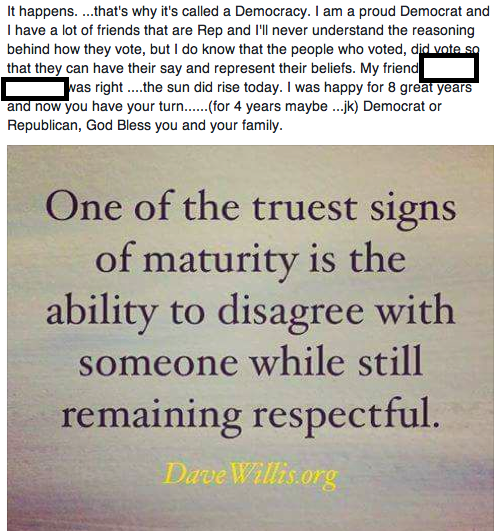Benkler’s reading describes how the development of technology has allowed for networked social media, such as Facebook, to become everyday use in society. However, according to Benkler, it has allowed for “political public sphere” (line 5 of “Democracy” The Networked Public Sphere”) to grow significantly.
Social media has given people the freedom to “participate in creating information and knowledge” (line 2 of “Democracy” The Networked Public Sphere”). This has therefore allowed people to share “political salient information, observations and comments and provide a platform for discourse” ((line 21 of “Democracy” The Networked Public Sphere”).
I agree with Benkler as my social media platforms (Facebook, twitter, etc.) are currently riddled with pro Trump or pro Hilary supporters sharing news, humiliating memes and/ or their own (clearly obvious) political expertise (why aren’t they president I wonder?).
However, what should be a calm, enlightening and open-minded experience of political discourse, it is actually the equivalent of a UFC-styled Octagon cage free-for-all, with a political twist.
People go head to head with each other to the extent that it feels like World War 3 is between filter uniformed keyboard warriors equipped with memes and shares of (in my opinion) inaccurate news sources such as “DailyWire”. Take a look at the following sample of what facebook has to offer:
Fig 2.
Fig 3.
Fig 4.
Benkler labels this phenomenon as the “Babel Objection” where “when everyone can speak, no one can be heard, and we devolve either to a cacophony or to the reemergence of money as the distinguishing factor between statements that are heard and those that wallow in obscurity” (line 6 of “Democracy” The Networked Public Sphere”). This is exactly what social media has snowballed into as more people now have access to the discourse platform and are therefore sharing their often-differing opinions. Examples of this can be seen in the following screen grabs:




Furthermore, the use of the word “cacophony” (a harsh, discordant mixture of sounds) is an accurate description because the discourse platform isn’t moderated and is not necessarily conducted in real time, therefore making the progression of the debate fragmented and untamed. For example, when the United Kingdom left the EU my Facebook was on fire with heated arguments over what was best for the country. Many of those people voted to leave refereed to the point that the money we would save could be spent on a better health services. However, following the decision to leave, Nigel Farage (a politician campaigning to leave) came out on national television and went back on what he said claiming that they probably wouldn’t spend the money on the health care system. This of course left many people outraged and made those Facebook supporters look stupid from the point of view of someone looking back on that argument.
To conclude, I agree with Benkler’s argument that the “political public sphere” has grown, and it has led to the point where the “Babel Objection” has come true, which has negatively affected this discourse platform.
